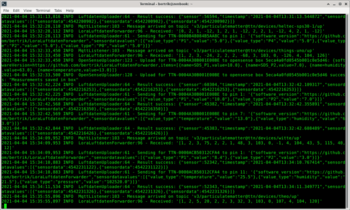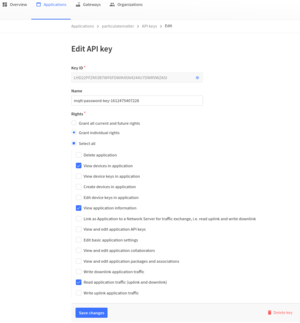Sensor-data-bridge: Difference between revisions
| Line 139: | Line 139: | ||
Values are read from the noise sensor using a single I2C block read. | Values are read from the noise sensor using a single I2C block read. | ||
These values are encoded as 32-bit units, interpreted as 32-bit floats. | These values are encoded as 32-bit units, interpreted as 32-bit floats. | ||
References: | |||
* DNMS is read at https://github.com/opendata-stuttgart/sensors-software/blob/beta/airrohr-firmware/airrohr-firmware.ino#L3392 | |||
* DNMS is formatted in the JSON at https://github.com/opendata-stuttgart/sensors-software/blob/beta/airrohr-firmware/airrohr-firmware.ino#L3405 | |||
* DNMS I2C code is at https://github.com/opendata-stuttgart/sensors-software/blob/beta/airrohr-firmware/dnms_i2c.cpp | |||
Revision as of 07:14, 6 April 2021
| Project LoraLuftdatenForwarder | |
|---|---|

| |
| LoRaWAN forwarder for particulate matter data | |
| Status | In progress |
| Contact | bertrik |
| Last Update | 2021-04-06 |
What is this
This is a companion project of LoraWanDustSensor.
It is a Java application that takes airborne particulate matter measurement data transferred through TheThingsNetwork and forwards it to http://sensor.community (formerly Luftdaten) and http://opensensemap.org .
Features
- Picks up particulate matter measurement data received through TheThingsNetwork, using their "v3" infrastructue
- Forwards measurement data to sensor.community
- Forwards measurement data to opensensemap.org, you can configure the opensense-id by adding a device attribute in TheThingsNetwork console
- Supports Cayenne payload format for the data encoding
- Handles particulate matter data (PM10, PM4.0, PM2.5, PM1.0), temperature, humidity, barometric pressure
- Can be run as a systemd service, so it automatically restarts in case the software would crash
Next steps
- add support for NB-IOT modem with t-mobile backend, see my Sim7020 project
- add support for other backends, e.g. feinstaub-app?
Requirements
You need the following:
- a server that is always on and connected to the internet, can be Linux or Windows
- a Java installation (JDK to compile), at least version 8
- some configuration on TheThingsNetwork side
- some configuration of my application (YAML file)
Compilation
To compile the software:
- clone the software from my github archive
git clone https://github.com/bertrik/LoraLuftdatenForwarder.git
- enter the LoraLuftdatenForwarder/gradle directory
cd LoraLuftdatenForwarder/gradle
- run the gradle script to build the software:
./gradlew assemble
- the application zip & tar is now available in LoraLuftdatenForwarder/LoraLuftdatenForwarder/build/distributions
To update to the latest version:
- Update software from github archive:
git pull
- perform the last two steps above again
Installation
Unzip the distribution file somewhere on your system. I put it in my home directory, for example
cd tar xvf code/LoraLuftdatenForwarder/LoraLuftdatenForwarder/build/distributions/LoraLuftdatenForwarder.tar
Configuration
Node configuration
The particulate matter measurement device needs to send data in the Cayenne format. I used the following conventions:
- PM10 is encoded as analog value on channel 1
- PM2.5 is encoded as analog value on channel 2
- PM1.0 is encoded as analog value on channel 0 (optional)
- PM4.0 is encoded as analog value on channel 4 (optional)
- Temperature is encoded using standard Cayenne encoding (optional)
- Humidity is encoded using standard Cayenne encoding (optional)
- Barometric pressure is encoded using standard Cayenne encoding (optional)
TheThingsNetwork application/device configuration

You need to define an 'application' on TheTheThingsNetwork.
- Go the TTN console: https://console.cloud.thethings.network/ and log in
- You need an 'application', create a new one, or use an existing one
- Within the application you need a 'device', so create a new one, or use an existing one:
- Use OTAA, LoRaMac version probably 1.0.3
- Enter the device EUI as displayed on the display
- Use the application keys as specified in my LoraWanDustSensor page
- You need an API key
- Create this on the TTN console, grant individual rights as shown in the screenshot
- NOTE: you have only one chance to copy this key somewhere, so copy/paste it locally to a text file or something
LoraLuftdatenForwarder configuration
To configure the application:
- Start the application without a configuration file, this will create a default template, stop the application again
cd LoraLuftdatenForwarder bin/LoraLuftdatenForwarder (ctrl-C)
- Edit the loraluftdatenforwarder.yaml file, example:
---
ttn:
mqtt_url: "tcp://eu1.cloud.thethings.network"
identity_server_url: "https://eu1.cloud.thethings.network"
identity_server_timeout: 20
apps:
- name: "particulatematter"
key: "NNSXS......."
encoding: "CAYENNE"
luftdaten:
url: "https://api.sensor.community"
timeout: 20
opensense:
url: "https://api.opensensemap.org"
timeout: 20
So:
- enter the name of your application
- enter the TTN API key you saved earlier
- other defaults are probably OK
Sensor.community
TODO
- Go to https://devices.sensor.community/ and log in
- Register a node with id 'TTN-<device-EUI-as-shown-on-display>' (without the spaces or hyphens, e.g. 'TTN-0000547AF1BF713C')
- Register it with the proper configuration, e.g. SDS011 with BME280
Opensensemap
- Go to opensensemap.org and log in
- Create an opensense node with the proper configuration
- Copy the opensensenmap 'box id', a long hexadecimal string
- Go the TTN console: https://console.cloud.thethings.network/ and log in
- Add an attribute for the device, under 'General settings', name = 'opensense-id', value = 'box id' (without the quotes) that you copied from opensensemap.org
- The boxid should be picked up automatically by the forwarder, within an hour
Work in progress
Forwarding noise data
How it is encoded in the sensor.community firmware:
- Three values are sent in the JSON to sensor.community:
- "noise_LAeq", value in dB(A), meaning?
- "noise_LA_min", value in dB(A), some kind of minimum
- "noise_LA_max", value in dB(A), some kind of maximum
I think these can be encoded in Cayenne as a simple analog value (which has a range of approximately -327..327 with a resolution of 0.01. Just need to assign a channel number to it.
Values are read from the noise sensor using a single I2C block read. These values are encoded as 32-bit units, interpreted as 32-bit floats.
References:
- DNMS is read at https://github.com/opendata-stuttgart/sensors-software/blob/beta/airrohr-firmware/airrohr-firmware.ino#L3392
- DNMS is formatted in the JSON at https://github.com/opendata-stuttgart/sensors-software/blob/beta/airrohr-firmware/airrohr-firmware.ino#L3405
- DNMS I2C code is at https://github.com/opendata-stuttgart/sensors-software/blob/beta/airrohr-firmware/dnms_i2c.cpp